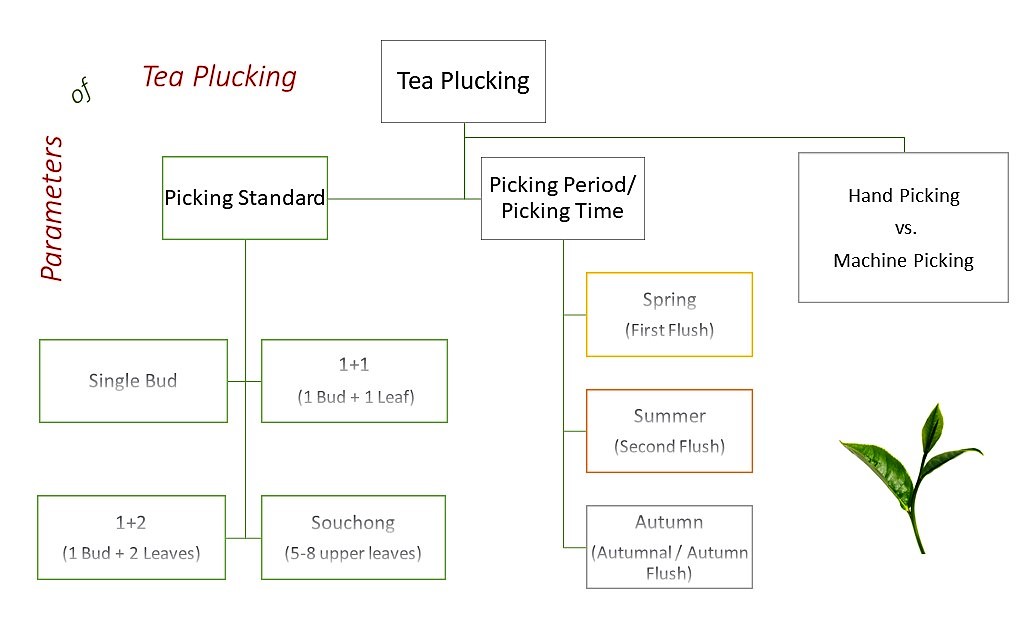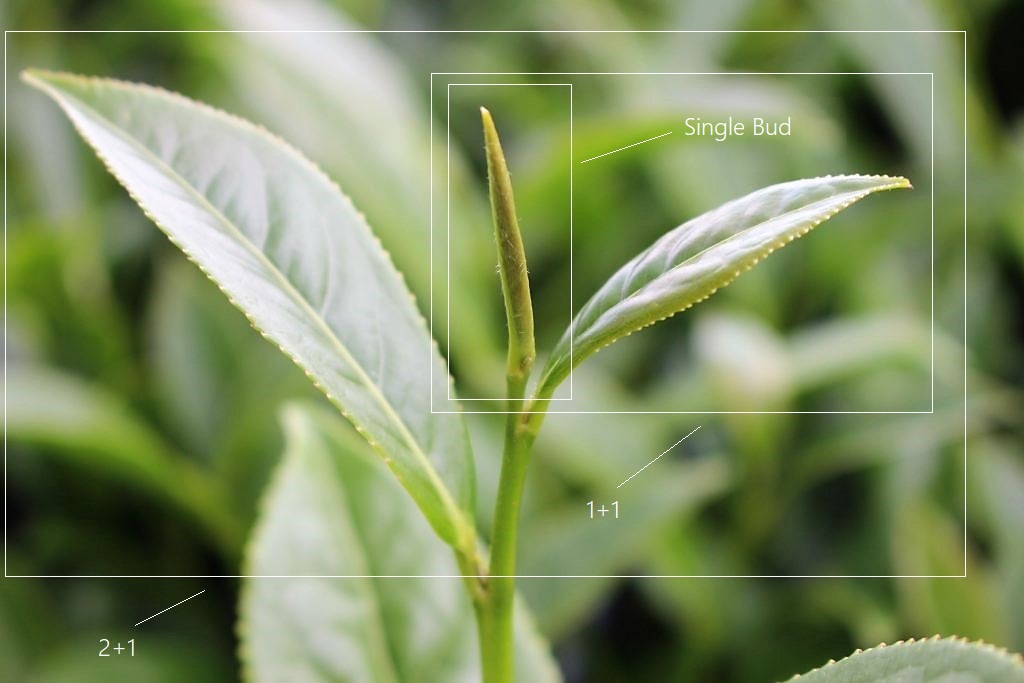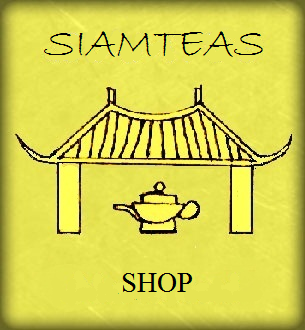Part 7 of our little Tea ABC deals with # 5 of the 8 factors influencing the identity and quality of the tea in your cup, the tea plucking. Essentially, the quality of tea plucking grounds on 2 main parameters, which are picking standard and picking period. In modern industrial production settings, to these adds the factor of hand picking vs. machine picking.
Tea Plucking Parameter #1 : Picking Standard
The picking standard indicates how high the proportion of buds in the picked leaf material is. For many teas this is defined, for others it is variable within certain limits. Where the picking standard is variable, the quality of the resulting tea varies with it. Basically, we distinguish the following picking standards:
- Single Bud – Only the young, still unopened bud is picked. Popular examples of this aree White Silver Needle tea or Yunnan Golden Tips.
- 1 + 1 – One young, still unopened bud each along with the youngest leaf attached to it qualify for picking. For example, this is the picking standard for some popular Chinese green teas such as Zi Sun Cha, Anji Bai Cha, Mao Feng or Long Jing tea. However, Long Jing tea is also an example of a tea that can as well do with the next lower picking standard:
- 1 + 2 – One young, still unopened bud along with the two youngest leaves attached to it qualify for picking. This picking standard is quasi the “royal” standard for the plucking of most teas.
- “Souchong” – several larger (and older) leaves along with the young tip qualify for picking. The term “Souchong” comes from Wuyishan, where this is the traditional picking standard for the famous Lapsang Souchong. Essentially, however, comparable picking standards widely find use elsewhere for the production of cheaper teas for the mass market.
- For many Oolong teas, among them popular examples such as Tie Guan Yin Oolong Tea, no young unopended buds are picked at all. Here, the picking standard begins with the first fully unfolded leaf from the top of the branch. How far it reaches down the branch, however, again has significant influence on the quality of the resulting tea.
Picking Standard and Taste
An interesting question, of course, is how the picking standard affects the taste of the tea in your cup. Of course, this is not the same for all teas. For example, we have already seen above that there are quite some exceptions to the rule. Nevertheless, a trend is indicatable for those teas that do follow the rule.
This tendency is due to the fact that the tea plant drives active ingredients and flavorings predominantly into its youngest leaves. Accordingly, the young bud expresses the subtleties and individual characteristics of a cultivar and related terroir most pronouncedly. For example, it is mainly responsible for floral and fruity notes. Older, larger leaves, on the other hand, contribute rather earthy flavors to a tea.
The interplay of both parts of the plant results in both complexity and mouthfeel. If we experience a tea as full-bodied, complex and harmonious, this proves a successful combination of the taste properties of leaf and bud. Accordingly, the picking standard of 2 + 1 has established as the “royal” standard for so many types of tea, because it creates a good balance between the different taste characteristics of bud and leaf. While a higher proportion of leaves results in a “cruder” tea, a lack of leaves costs the tea its “grounding”.
Tea Plucking Parameter #2 – Picking Period / Picking Time (“Invoice”)
There is also a “royal” standard for the best time or period for the tea plucking, which is spring. In other words, the first young shoots picked after the winter provide for the best tea. Accordingly, the spring picking is the standard for many teas. Examples include virtually all green teas in China, Japan and elsewhere, as well as Indian “first flushes” and many oolong and black teas.
When exactly spring and/or the tea plucking begins, depends on the climate in each growing region. But even within individual picking periods there are quality and resulting price differences. This is especially true for the spring picking. For example, the very first spring pickings from Darjeeling or the “pre-Qingming” picking of a Long Jing tea always score record prices.
Nonetheless, in most tea gardens, the annual tea plucking course spans three picking periods, spring, summer and autumn. Only the “hibernation” of tea plants during winter is a standard that is common to all teas and cultivation areas. Accordingly, an early or later picking time applies as a quality feature of a tea that will also be reflected in its price.
Well, of course, there are exceptions to this rule… There are teas, such as the Tie Guan Yin, where the tea of the autumn picking is considered the tastiest. Other cultivars produce a special taste in autumn that deviates from that of the tea of earlier pickings. And of course, here too, in the end everything is “a matter of taste” … For example, a declared lover of Darjeeling Second Flushes (summer plucking) will not agree with the above-proclaimed general supremacy of spring flushes.
Classic Indian Leaf Grades and Picking Standards – from Pekoe to SFTGFOP 2
After the initial spark of tea cultivation in India in the mid-19th century, the British pushed the same on a large scale. The aim was to satisfy the increasing demand at home, independent from China imports. In particular, cheaper tea was to be produced, which would be affordable for the common people in England, too. With such premises, the “royal” standard of tea plucking, “two leaves and one bud”, inevitably had to fall by the wayside. Instead, a separate grading system was developed, allowing to distinct and identify different qualities within a wide range of picking standards. In addition to information about the picking standard, this code also contains the so-called “leaf grade”, which is more of a processing characteristic than a picking standard. Further, the code, consisting of letters and numbers, contains hints on picking period, time and cultivar (eg CL = clonal).
Here is a brief overview:
Indian Leaf Grades:
- Orange Pekoe (= OP) – whole long leaves of good quality, whereas “pekoe” simply means “tea leaf”.
- Broken (B) – If a B appears in the abbreviation, as in FBOP, the B stands for “Broken” (in the example: Flowery Broken Orange Pekoe), which means that whole leaves are of good quality with a small proportion of Buds were crushed. “Broken” leaf grades are quite popular among lovers of Indian black tea, as the crushed tea leaves develop flavor and color in the infusion faster and more intense.
- Fannings – especially low-quality, non-“Orange Pekoe” tea leaves are finely chewed for the most intense flavor and rapid infusion. Fannings teas – just like “Dust” (see below) – suit well for presentation in teabags.
- Dust – lowest leaf grade : small bits of a usually not further specified leaf quality form the rear light on the scale of Indian tea leaf grades.
Indian Picking Standards:
- Flowery Orange Pekoe (FOP) – Orange Pekoe with small proportion of buds.
- Golden Flowery Orange Pekoe First Grade (GFOP) – like FOP, but with higher ratio of buds.
- Tippy Golden Flowery Orange Pekoe (TGFOP) – the tea with the highest proportion of buds (tippy).
- Finest Tippy Golden Flowery Orange Pekoe (FTGFOP) – corresponds to about 25% share of tips (tippy).
- FOP 1 / FOP 2 – The number additinally indicates the “invoice”, ie the exact day of picking within a picking period.
FF / SF / Autumnal – First Flush (spring), Second Flush (summer), Autumn Flush (autumn)
Today, this system has come a little “out of fashion”. This is not least due to the fact that the grades remain vague in terms of actual measures. In other words, how high the proportion of buds in FTGFOP really is – or how much higher than that in TGFOP – remains unclear. Therefor, the system of “mathematically defined” picking standards as presented at the beginning of this lesson is much more informative, especially for tea drinkers and buyers at the end of the chain.
Tea Plucking Parameter #3 – Hand Picking vs. Maschine Picking
Before the industrialization of tea cultivation and the associated invention of relevant machines, tea plucking was only by hand. Although the picking of tea leaves in compliance with a given picking standard requires no academic graduation, it certainly requires a good deal of skill and practice. Anyone who has ever watched tea pickers at work knows that speed plays an important role with tea plucking. This is because the yield must feed the picker as well, who is usually paid by weight.
And this is where the picking machine comes into play… It comes with a calculable cost-income ratio, needs no breaks and no holidays. In addition, it doesn’t strike for higher wages, does not represent political views and is otherwise free of any “human flaws”. For a long time, the poor implementation of specific picking standards made tea plucking by conventional picking machines inferior to hand picking. Too many branches, shredded leaves, etc. Meanwhile, however, there are also “intelligent” picking machines that separate leaves of a configurable picking standard very precisely from the shrub. The associated technology comes mainly from Japan, where the tea industry has reached a very high degree of automation.
In light of such sophisticated technology, the question of which method of tea plucking is the better one seems to be of ideological rather than qualitative nature. Or should the handpicked compared to the machine-picked tea leaf have some hidden qualities? As even in Japan tea masters pick their very best teas, eg for participation in competitions, by hand until today.
Recommended Accompanying Materials
As an accompanying and in-depth source for this part 7 of the Little Tea School, I recommend reading my pertinent article in the Siam Tea Blog / THE TEESPIEGEL:
Leaf Grade, Picking Standard, Processing Standard – Objective Tea Quality Evaluation Criteria
One more thing, on my own account…
Do you like this article? Support the maintenance and further development of “My Little Tea School – The ABC of TEA” through your shopping at



